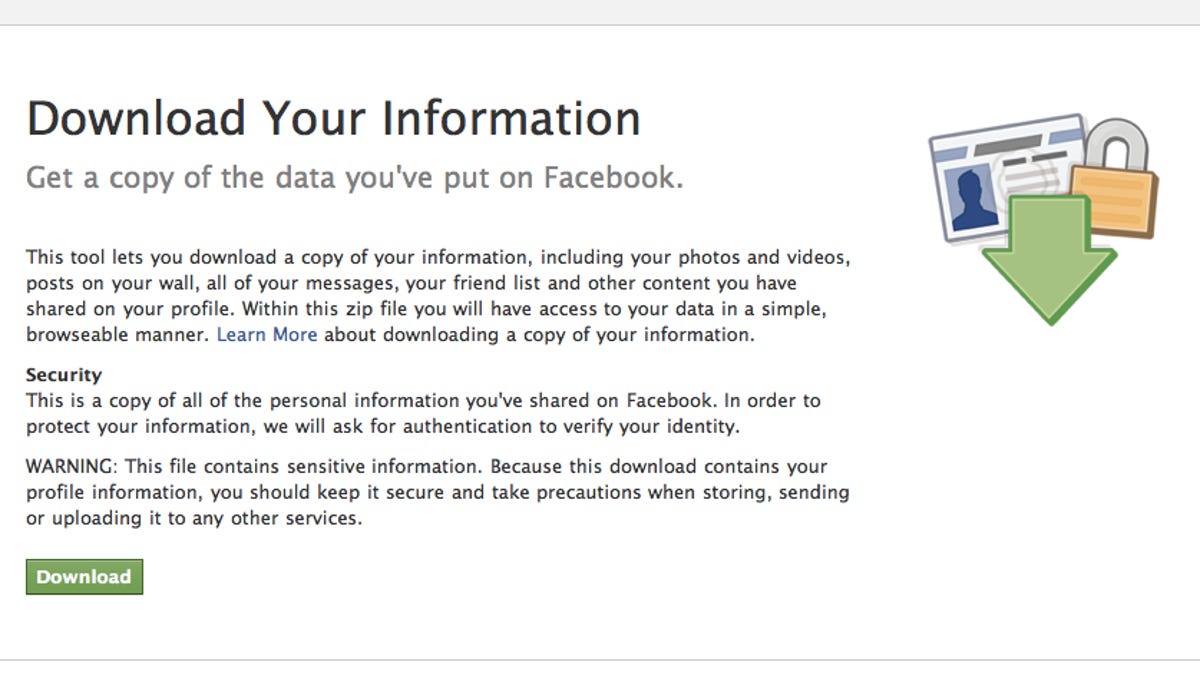Hands-on with Facebook's data downloader
The new tool squeezes your entire Facebook identity into a tidy little zip file. CNET's Josh Lowensohn checks out the fit.

Among the three new features introduced by Facebook last week, one of the last ones to make it to the hands of users was the personal data downloader. It's also one of the most interesting of the bunch, since it effectively gives users an escape hatch to grab everything they've ever uploaded to Facebook and take it elsewhere.
The feature finally went live over the weekend, and I've had a chance to put it through its paces. The good news is that it's one of the simplest options I've ever seen for such a large amount of data. The bad news is that because it's just your information, you may find it's missing a lot of things that include you, but that were uploaded by others.
So what does the service do? It grabs every photo, video, wall post, private message, event, and scrap of profile information from your Facebook account, and puts into a tidy little zip file. In essence, it's your entire Facebook identity in just a folder.
To get this wealth of information, you have to jump through a handful of security hoops. Even if you're signed into Facebook, you need to re-enter your password to request it. Also, if you're on a computer that Facebook is unfamiliar with, it will ask you to solve a captcha. Facebook will then beginning pulling together all those files, which it does in the background, before sending you an e-mail to let you know it's done.
For me, the turnaround time from filling out my information to getting the download link was less than 10 minutes. And the size of the download? 270MB.
Once you have that file in hand, your profile is broken into folders. This includes photos and videos, though unfortunately, this works out a little better for videos than it does for photos.
Every single video I had uploaded was preserved with the exact same file I had uploaded. The photos, on the other hand, had all been run through Facebook's processing, and ran the gamut from 604 pixels wide, to the newer 720 pixel wide format--in either case, that's tiny. The good news is, going forward this won't be as much of a problem, since Facebook recently increased its photo resolution (and thus the preserved file download) to a 2048 pixels wide--an eight-fold increase.
My bigger objection to the process was that some of the original metadata--like when the photo had been taken--gets stripped in the process. Why is this important, you ask? Say you want to stick those photos into a photo management tool, you can no longer sort them by date. The good news on that front is that your collections are preserved as subfolders within the main photos folder, so you have some frame of reference.
Traversing through all these images, and the rest of the data that comes with the download, has been made a very straightforward affair. Each photo collection is stuck into its own folder, and if you want to navigate them much like you would in Facebook, you can simply click on the "index.html" file that comes included in the zip folder. This opens up a bare bones profile view in your desktop's browser that surfs these files offline in much the same manner you would if you were online:
This system ends up working out well for photo galleries and wall posts, though not as well for the log of your events and private messages--two places where order can make it easier to get through what can be a staggering amount of information. How staggering? My wall was close to 300 pages long in my Web browser. It was the same story for my message in-box, where every conversation thread I had ever had was on one page.
One of the notable weak points of the saved data file--at least for the moment--is that there are a few missing pieces. For one, none of your friends get linked with their Facebook profile, so every time you see a name within one of the archived pages, you have to log-in to Facebook and do a search to find them. It would be much easier if they were linked up in the first place. I'm guessing this is a privacy feature, but given the public nature of Facebook's profile links and the inherent security that guards each profile, it seems out of character.
The other weak point is that any media items that were posted to your wall by another friend, or that include you (like a photo or video), do not come along for the ride. You do get thumbnails of things like photos and videos, but they do not get downloaded. Instead you can click on them to be taken to that live page on Facebook where they exist, which means you'll need an active Facebook account to see them if they're not public. Is this a huge deal? No, but it does make you realize how much of the content that's on the social network may not always be in your control.
These two hang-ups, and the long scrolling usability issue aside, the information downloader is a really useful feature and one that is decidedly simple to use. For photo and video enthusiasts alone, Facebook is now finally a place where you can grab your content and take it elsewhere in one big chunk, or simply get things back that may have been lost if and when something happens to the computer you have everything stored on.
The feature should be live for everyone now. To see a how-to on using it, you can watch the video embedded below:

